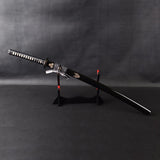In The Dead of Night
The castle gleamed alone before him, surrounded by mountains now invisibly wrapped in the dark shroud of night. Hanzō waited for the word to attack. All their preparation led up to this moment. At only 16 years of age, this was his first battle. As his fellow men got into position, only the consistent chirping of crickets and the calls of a few birds could be heard. His muscles felt tense, and he quickly ran through a few breathing exercises to calm himself. Finally the awaited command was passed down, and he felt a rush of newfound energy as the attack began.
Hattori Hanzō
Hattori Hanzō is arguably the most well-known ninja in modern times. His father was a minor samurai who served the Matsudaira clan. Hattori was born sometime around 1542 and lived 54 years until his death in November of 1596. He is often called Hattori Hanzō Masanari/Masashige I to distinguish him from other members of his family who carried the same name.
Hanzō exploits were due not to his skill as a warrior but to his ability as a commander (though he was an excellent spear fighter). He often used guerilla tactics on castles in place of direct assaults. Hattori fought in his first battle at the age of 16, when he attached Udo Castle at night. From then on, he participated in other battles including rescuing his daimyō’s (lord’s) hostage daughters at age 20 and sieging Kakegawa Castle at age 27. At age 30, he fought in the battle of Mikatagahara where he captured a spy and counter-attacked across a river with only 30 men. For these brave deeds he was awarded command of 150 men of an Iga ninja unit.
Fast forward a few years, and Hanzō was in charge of defending Iga province (the homeland of the ninjas) from a ferocious attack by Nobunaga. While he was ultimately unsuccessful, he was able to significantly slow enemy forces for two years until he was finally routed by forces under Nobunaga’s direct control. After Nobunaga’s timely death a year later, Hanzō made his most significant contribution yet: he helped Japan’s future shōgun (king) Tokugawa cross Mikawa province with the help of the remnants of the local Iga ninja clans.
Toward the end of his life, Hanzō gave up fighting and became a monk. He took the name “Sainen” and built a temple which was later named after him. Today, his remains are kept in Sainen-ji temple cemetery in Yostuya, Tokyo. His physical legacy lives on in the Imperial Palace, which has a gate that still retains his name. His cultural legacy is much more significant with many stories, films, and movies portraying different aspects of his life.
Kill Bill
One popular movie portrayal of a (fictional) descendant of his is in the movie Kill Bill. Here, the Bride needs a weapon powerful enough to kill Bill, so she goes to Hattori Hanzō (revealed in supplementary material to be the 14th in that line) who is widely known as the best swordsmith in the world. Though he had taken a blood oath not to make any more weapons of destruction and had kept it for 29 years, he decided to break it when he learned the sword would be destined to kill Bill. The resulting masterwork he considered to be the finest and sharpest sword of his career.
Here are replicas of the swords made by Hattori Hanzō from the Kill Bill movie series:
Fun Fact
Many tales ascribe to Hanzō powers of teleportation, precognition, and psychokinesis.
What’s in a Name
Unlike Western names, Eastern names start with the family name and end with the individual’s name. So Hattori Hanzō’s first name is actually Hanzō. His father and son also carried the same name. The Japanese Kanji for Hattori Hanzō are 服部 半蔵.
source https://www.bladespro.co.uk/blogs/news/hattori-hanzo



No comments:
Post a Comment